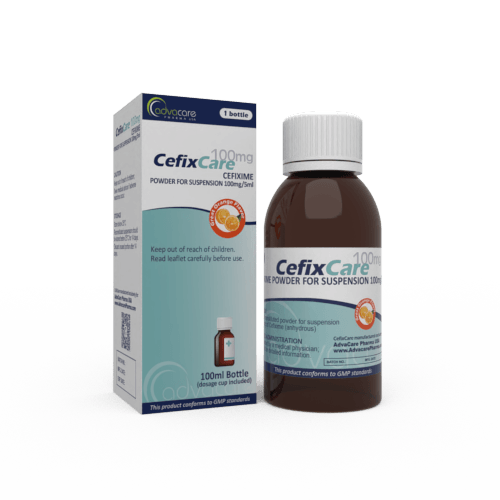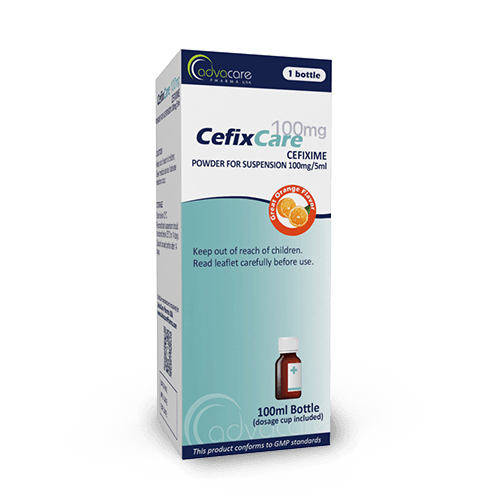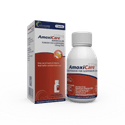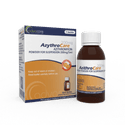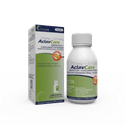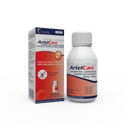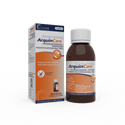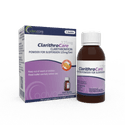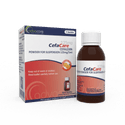- Home›
- Pharmaceuticals›
- Pharmaceutical Suspensions›
- Powder for Suspension›
- Cefixime for Oral Suspension
Cefixime for Oral Suspension
Dosage
Packaging
What is Cefixime?
Active Ingredients: Cefixime
Cefixime for Oral Suspension is an antibiotic drug used in the treatment of many types of bacterial infections, such as pneumonia, uncomplicated urinary tract infections, ear infections, lung infections, throat infections, and uncomplicated gonorrhea. It is also indicated for the treatment of typhoid fever.
Cefixime is active against certain gram-positive and gram-negative bacteria species, such as E. coli, Proteus mirabilis, and Streptococcus pyogenes. It is a third-generation beta-lactam antibiotic in the cephalosporin family, like ceftriaxone and cefotaxime. Cefixime is highly stable in the presence of beta-lactamase enzymes, allowing it to target organisms that are resistant to penicillins and some cephalosporins due to their beta-lactamase activity.
Cefixime exerts antibacterial effects in the bacterial cell wall, where it binds to specific penicillin-binding proteins (PBPs) to inhibit peptidoglycan synthesis. This effect inhibits the final stage of cell wall synthesis and results in bacterial cell death.
AdvaCare Pharma is a global distributor and manufacturer of Cefixime for Oral Suspension, Cefixime Capsules, and Cefixime + Ofloxacin Tablets. Our medical supplies are produced in GMP-certified facilities in China, India, and the USA. These factories are routinely inspected to ensure they meet the high standards necessary to comply with WHO guidelines and standards.
Why are we a quality Cefixime manufacturer?
AdvaCare Pharma, a GMP-compliant pharmaceutical company, specializes in the manufacture of Cefixime for Suspension. Our strategic manufacturing locations and innovative management systems ensure full control over the supply chain, resulting in enhanced quality standards and decreased costs throughout the production, transport and import processes. As a trusted Cefixime manufacturer, we globally supply a comprehensive range of 55+ oral liquid medicines in suspension dosage form to more than 65 countries.
Uses
What is Cefixime used for?
It is used to treat some types of bacterial infection, like:
- pneumonia
- uncomplicated urinary tract infections
- ear infections (otitis media)
- lung infections (acute bronchitis and acute exacerbations of chronic bronchitis)
- throat infections (pharyngitis and tonsillitis)
- uncomplicated gonorrhea (cervical/urethral)
Cefixime will not treat a viral infection, such as the common cold or flu.
How is Cefixime for Oral Suspension used?
This medication is manufactured as a powder, which must be mixed in water before oral consumption.
After reconstitution, the bottle should be shaken well before each dose. This medication can be taken with or without food.
It is important to note that Cefixime should be used for the full prescribed length of time, even if symptoms improve early on. Skipping doses or discontinuing prematurely may increase the risk of developing an infection that is resistant to present and future treatment.
How should Cefixime for Oral Suspension be stored?
When not in use, Cefixime for Oral Suspension should be stored away from light in a dry and cool environment between 15°C/60°F and 30°C/86°F.
After reconstitution, the suspension should be refrigerated (between 2°C/36°F and 8°C/46°F) to ensure it retains its efficacy. It should remain stable for up to 14 days in ideal conditions. Discard any remaining solution after 14 days.
What dose should be given and for how long?
Adults and Children (> 12 years and > 45kg) Dosage may vary based on different medical indications:
- For the treatment of gonorrhea, the recommended regimen is a single dose of 400mg.
- For the treatment of other bacterial infections, the recommended regimen is 400mg, taken once a day; OR 200mg, taken twice a day. Treatment durations are typically 10 days, unless otherwise instructed.
Children (6 months - 12 years and ≤ 45kg) Recommended dosage for children may vary based on different medical conditions:
- For the treatment of gonorrhea, the recommended regimen is a single dose of 8mg/kg.
- For the treatment of other bacterial infections, the recommended regimen is 8mg/kg, taken once a day; OR 4mg/kg, taken twice a day. Treatment durations are typically 10 days, unless otherwise instructed.
The exact dosage and treatment duration is based on the severity of the infections, age, sex, and weight. Refer to a doctor or pharmacist for guidelines.
What happens if a dose is missed?
Take the missed dose as soon as possible. Skip the missed dose if it is almost time for the next dose. Do not take two doses at once.
Who can use Cefixime?
Cefixime can be administered to adults and children (≥6 months), but caution is advised for specific groups of patients.
Pregnant Animal studies have not found evidence of fetal harm associated with cefixime administration at doses 40 to 80 times the maximum recommended human dose. Human data spanning several decades have not found evidence of increased risk of major birth defects, miscarriage, or adverse maternal or fetal outcomes associated with cephalosporin use during pregnancy.
Maternal gonorrhea may be associated with preterm birth, low birth weight, chorioamnionitis, intrauterine growth restriction, small for gestational age, and premature rupture of membranes. Gonorrhea transmitted to neonates during delivery may cause infant blindness, joint infections, and bloodstream infections. In cases of maternal gonorrhea, the benefits of cefixime may outweigh the potential risks.
Nursing There is no data on the presence of cefixime in human milk, its effects on nursing infants, or its effects on milk production. It has been found in animal milk and may likely be present in human milk. The benefits of breastfeeding, the patient’s clinical need, and any potential adverse infant events should all be considered when making decisions regarding cefixime therapy while nursing.
Pediatric In patients aged < 6 months, the safety and efficacy of cefixime have not been established.
Geriatric Clinical studies of cefixime therapy did not include sufficient older adults (≥ 65 years) to determine whether they respond differently than younger adults (< 65 years). Other reported clinical experiences have not revealed differences in responses. One pharmacokinetic study was able to detect small differences in parameters; however, they did not warrant dosage adjustments for older patients.
Other warnings
In patients with renal insufficiency, doses should be reduced.
Anaphylactic and anaphylactoid reactions, some of which can be fatal, have been reported with cefixime use. In hypersensitive patients, there is a potential for serious dermatologic reactions, such as toxic epidermal necrolysis (TEN), Stevens-Johnson Syndrome, and drug reaction with eosinophilia and systemic symptoms (DRESS). If skin rashes or other signs or symptoms of sensitivity reactions occur, cefixime should be discontinued immediately.
Exercise caution when administering cefixime to patients who are sensitive to penicillin, as beta-lactam antibiotic cross hypersensitivity may occur in up to 10% of these patients.
Clostridium difficile-associated diarrhea (CDAD) has been reported with use of nearly all antibiotic agents, including cefixime, and may range in severity from mild diarrhea to fatal colitis. Treatment with antibiotics alters the flora of the colon, which can lead to overgrowth of C. difficile. Certain strains of C. difficile can cause increased morbidity and mortality. Patients presenting with diarrhea up to weeks or months after the completion of cefixime treatment should be monitored for CDAD. If CDAD is suspected or confirmed, ongoing antibiotic use not intended to treat C. difficile may need to be discontinued. Appropriate fluid and electrolyte management, protein supplementation, antibiotic treatment of C. difficile, and surgical evaluation should be instituted as clinically indicated.
Administering cefixime in the absence of a proven or strongly suspected bacterial infection or prophylactic indication is unlikely to provide any clinical benefit and increases the risk of developing drug-resistant bacterial infections.
Immune-mediated hemolytic anemia has been observed with cephalosporin use. Severe cases, some of which have been fatal, have been reported in adults and children. Cefixime should be discontinued in patients that develop anemia during treatment until drug-associated anemia is ruled out.
Cephalosporins, including cefixime, may be associated with an increase in prothrombin time. This risk is increased in patients with renal or hepatic insufficiency, poor nutritional state, those receiving prolonged antimicrobial therapy, and those who are taking anticoagulants. Prothrombin time should be monitored in such patients, and supplemental vitamin K may be administered, if needed.
Cefixime administration may result in false-positive reactions for urine ketones with tests using nitroprusside. False-positive urine glucose can also occur when using nonenzymatic detection methods. Tests based on enzymatic glucose oxidase reactions should be used while receiving cefixime treatment.
False-positive direct Coombs tests have been reported with other cephalosporins and may be possible with cefixime.
Side Effects
As with all pharmaceuticals, some unwanted effects can occur from the use of Cefixime for Oral Suspension.
Common side effects include, but may not be limited to:
- heartburn
- nausea
- stomach pain
- gas
- diarrhea
Seek medical attention if the following develop:
- severe allergic reactions (rash, hives, itching, difficulty breathing, tightness in the chest, and swelling of the mouth, face, lips, or tongue)
- unusual bruising
- decreased urination
- fever
- severe, bloody or watery diarrhea
- unusual tiredness or weakness
- yellowing of the skin or eyes
For a comprehensive understanding of all potential side effects, consult a medical professional.
If any symptoms persist or worsen, or you notice any other symptoms, please call your doctor immediately.
Precautions
Do NOT use Cefixime for Oral Suspension if:
- You are allergic to cefixime, any of its ingredients, or other cephalosporin antibiotics.
- You have an upcoming surgery.
Cefixime may not be suitable for people with certain conditions, so it is important to consult with a doctor if:
- You have renal impairment.
- You have a certain type of colitis.
Use of cefixime during pregnancy or breastfeeding is only recommended when the benefits outweigh the risk. While adverse effects are unlikely, the patient, fetus, and nursing infant should be monitored closely.
References
Mechanism of Therapeutic Effectiveness of Cefixime against Typhoid Fever
β-Lactams are generally ineffective against organisms residing inside mammalian cells due to their limited ability to penetrate these cells, but cefixime has demonstrated clinical efficacy against typhoid fever.
This study explored the mechanism behind cefixime's therapeutic effectiveness against typhoid fever, in both cellular and mouse infection models.
Cefixime successfully inhibited the growth of serovar Typhimurium within monocyte-derived THP-1 cells. Microscopic analysis revealed elongation of serovar Typhimurium inside THP-1 cells, and electron microscopy showed significant morphological changes in these bacteria.
The concentration of cefixime inside THP-1 cells was approximately 46 to 48% of the external concentration when serovar Typhimurium was present. An oral dose of 8mg/kg, of cefixime remained in the serum at concentrations above the MIC required to inhibit 90% of serovar Typhi organisms within human cells for more than 12 hours. Cefixime exhibited excellent activity in mouse models of systemic and oral infections caused by serovar Typhimurium.
The conclusion is that this antibiotic is capable of penetrating mammalian cells in significant amounts and can inhibit the growth of intracellular bacteria.

You might be interested in...
Why AdvaCare Pharma?
As an industry leader, we are aware of our responsibility to provide affordable and sustainable solutions to improve healthcare worldwide.
